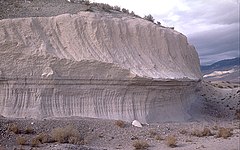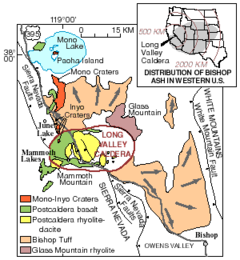| Bishop eruption | |
|---|---|
 Two layers of the Bishop Tuff: lower layer was from ashfall, upper layer was from the main pyroclastic flow. | |
| Volcano | Long Valley Caldera |
| Date | 764,800 ± 600 years ago |
| Type | Ultra-Plinian |
| Location | California, United States 37°43′00″N 118°53′03″W / 37.71667°N 118.88417°W |
| Volume | Approx. 200 km3 (48 cu mi) |
| VEI | 7 |
 Map of the Long Valley Caldera, with Bishop Tuff outlined. | |
The Bishop Tuff is a welded tuff which formed 764,800 ± 600 years ago as a rhyolitic pyroclastic flow during the approximately six-day eruption that formed the Long Valley Caldera.[1][2][3] Large outcrops of the tuff are located in Inyo and Mono Counties, California, United States. Approximately 200 cubic kilometers of ash and tuff erupted outside the caldera.[4]
- ^ Andersen, Nathan L.; Jicha, Brian R.; Singer, Brad S.; Hildreth, Wes (2017). "Incremental heating of Bishop Tuff sanidine reveals preeruptive radiogenic Ar and rapid remobilization from cold storage". Proceedings of the National Academy of Sciences. 114 (47): 12407–12412. Bibcode:2017PNAS..11412407A. doi:10.1073/pnas.1709581114. ISSN 0027-8424. PMC 5703294. PMID 29114056.
- ^ Crowley, J.L.; Schoene, B.; Bowring, S.A. (December 2007). "U-Pb dating of zircon in the Bishop Tuff at the millennial scale". Geology. 35 (12): 1123–1126. Bibcode:2007Geo....35.1123C. doi:10.1130/G24017A.1.
- ^ Hildreth, Wes; Wilson, Colin J. N. (2007). "Compositional Zoning of the Bishop Tuff". Journal of Petrology. 48 (5): 951–999. doi:10.1093/petrology/egm007. ISSN 1460-2415.
- ^ "Bishop Tuff in Long Valley Caldera, California". Long Valley Caldera. United States Geological Survey. Retrieved 2021-12-06.